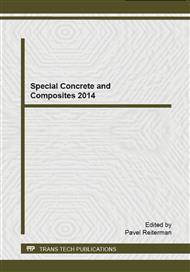[1]
J. Bensted, P. Barnes, Structure and Performance of Cements, Spon Press, London, 2002. ISBN 0-203-47778-2.
Google Scholar
[2]
Y. Ohama, Handbook of Polymer-Modified Concrete and Mortars, Noyes Publications, New Jersey, 1995. ISBN 0-8155-1358-5.
Google Scholar
[3]
E. Knapen, D.V. Gemert, Effect of Under Water Storage on Bridge Formation by Water-Soluble Polymers in Cement Mortars, Construction and Buildings Materials 23 (2009) 3420-3425. ISSN 0950-0618. DOI: 10. 1016/j. conbuildmat. 2009. 06. 007.
DOI: 10.1016/j.conbuildmat.2009.06.007
Google Scholar
[4]
E. Knapen, D.V. Gemert, Cement hydration and microstructure formation in the presence of water-soluble polymers, Cement and Concrete Research 39 (2009) 6-13. ISSN 0008-8846. DOI: 10. 1016/j. cemconres. 2008. 10. 003.
DOI: 10.1016/j.cemconres.2008.10.003
Google Scholar
[5]
P. Viswanath, E.T. Thachil, Properties of polyvinyl alcohol cement pastes, Materials and Structures 41 (2008) 123-130. ISSN 1871-6873. DOI: 10. 1617/s11527-007-9224-2.
DOI: 10.1617/s11527-007-9224-2
Google Scholar
[6]
T.M. Pique, A. Vazquez, Control of hydration rate of polymer modified cements by the addition of organically modified montmorillonites, Cement and Concrete Composites 37 (2013) 54-60. DOI: 10. 1016/j. cemconcomp. 2012. 12. 006.
DOI: 10.1016/j.cemconcomp.2012.12.006
Google Scholar
[7]
R. Morlat, G. Orange, Y. Bomal, P. Godard, Reinforcement of hydrated Portland cement with high molecular mass water-soluble polymers, Journal of Materials Science 42 (2007) 4858-4869. ISSN 1573-4803. DOI: 10. 1007/s10853-006-0645-z.
DOI: 10.1007/s10853-006-0645-z
Google Scholar
[8]
N.B. Sing, S. Rai, Effect of polyvinyl alcohol on the hydration of cement with rice husk ash, Cement and Concrete Research 31 (2001) 239-243. ISSN 0008-8846. DOI: 10. 1016/S0008-8846(00)00475-0.
DOI: 10.1016/s0008-8846(00)00475-0
Google Scholar
[9]
H. E. Yongjia, et al., Effect of Water Soluble PVA on the Microstructure Characteristics of C-S-H Formed in Na2SiO3Ca(NO3)2 Solution System. Journal of Wuhan University of Technology-Mater. Sci. Ed. 26 (2011).
DOI: 10.1007/s11595-011-0266-5
Google Scholar
[10]
J.H. Kim, R.E. Robertson, Effects of Polyvinyl Alcohol on Aggregate-Paste Bond Strength and Interfacial Transmition Zone, Advanced Cement Based Materials 8 (1998) 66-76, ISSN 1065-7355. DOI: 10. 1016/S1065-7355(98)00009-1.
DOI: 10.1016/s1065-7355(98)00009-1
Google Scholar
[11]
J. H Kim, R.E. Robertson, A.E. Naaman, Structure and properties of poly(vinyl-alcohol)-modified mortar and concrete, Cement and Concrete Research 29 (1999) 407-415. ISSN 0008-8846. DOI: 10. 1016/S0008-8846(98)00246-4.
DOI: 10.1016/s0008-8846(98)00246-4
Google Scholar
[12]
S.C. Mojumdar, L. Raki, Preparation and properties of calcium silicate hydrate-poly(vinyl alcohol) nanocomposite materials. Journal of Thermal Analysis and Calorimetry 82 (2005) 89-95. DOI: 10. 1007/s10973-005-6837-y.
DOI: 10.1007/s10973-005-0846-8
Google Scholar
[13]
S.C. Kou, et al., Structure Properties of concrete prepared with PVA-impregnated recycled concrete aggregates. Cement and Concrete Composites 32 (2010) 649-654. DOI: 10. 1016/j. cemconcomp. 2010. 05. 003.
DOI: 10.1016/j.cemconcomp.2010.05.003
Google Scholar
[14]
ASTM E1876-01, Standard Test Method for Dynamic Young's Modulus, Shear Modulus, and Poisson's Ratio by Impulse Excitation of Vibration, Annual Book of ASTM Standards, American Society for Testing and Materials, (2006).
DOI: 10.1520/c1548
Google Scholar
[15]
P. Padevět, P. Tesárek, P., T. Plachý, Evolution of mechanical properties of gypsum in time, International Journal of Mechanics 5 (2011) 1-9.
Google Scholar
[16]
M. Lidmila, P. Tesárek, T. Plachý, Z, Rácová, P. Padevět, V. Nežerka, O. Zobal, Utilization of recycled fine-ground concrete from railway sleepers for production of cement-based binder, Applied Mechanics and Materials 486 (2014).
DOI: 10.4028/www.scientific.net/amm.486.323
Google Scholar
[17]
V. Nežerka, Z. Slížková, P. Tesárek, T. Plachý, D. Frankeová, V. Petráňová Comprehensive study on mechanical properties of lime-based pastes with additions of metakaolin and brick dust, Cement and Concrete Research 64 (2014).
DOI: 10.1016/j.cemconres.2014.06.006
Google Scholar
[18]
L. Horníček, P. Tyc, M. Lidmila, H. Krejčiříková, P. Jasanský, P. Břešt'ovský, P., An investigation of the effect of under-ballast reinforcing geogrids in laboratory and operating conditions, Proceedings of the Institution of Mechanical Engineers, Part F: Journal of Rail and Rapid Transit 4 (2010).
DOI: 10.1243/09544097jrrt330
Google Scholar
[19]
H. Krejcirikova, M. Lidmila, Experimental and mathematical analysis of a multi-layer system of railway track, Komunikacie 6 (2004) 44-46. ISSN: 13354205.
DOI: 10.26552/com.c.2004.3.44-46
Google Scholar
[20]
P. Tesárek, T. Plachý, P. Ryparová, J. Němeček, Micromechanical properties of different materials on gypsum basis, Chemicke Listy, 106 (2012) s547-s548. ISSN 0009-2770.
Google Scholar
[21]
P. Tesárek, J. Němeček, Microstructural and micromechanical study of gypsum, Chemicke Listy, 105 (2011) s852-s853. ISSN 0009-2770.
Google Scholar


